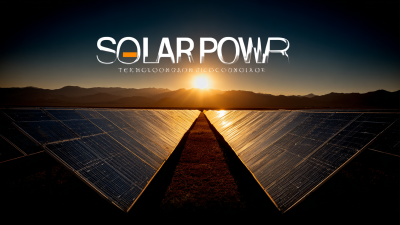Unlocking the Power of Solar With Light: A Comprehensive Guide to Sustainable Energy Solutions
The transition towards sustainable energy solutions has become a critical focus in combating climate change and ensuring energy security. Among the promising innovations in this realm is the integration of solar energy with advanced light management technologies, collectively referred to as "Solar With Light." According to the International Energy Agency (IEA), solar power is projected to be the largest source of electricity globally by 2030, with installed capacities reaching over 3,000 GW, driven by enhanced efficiencies and decreasing costs of photovoltaic systems. Additionally, a recent report from the National Renewable Energy Laboratory (NREL) highlights that optimizing solar energy output through innovative light harnessing techniques can increase efficiency by up to 30%. This comprehensive guide aims not only to explore the multifaceted benefits of "Solar With Light," but also to provide actionable tips for harnessing this technology for a sustainable future.

Understanding Solar Energy: Principles and Innovations
Solar energy has emerged as a cornerstone of sustainable energy solutions, leveraging the sun’s abundant power to provide clean and renewable energy. Understanding the principles of solar energy involves familiarizing oneself with concepts like photovoltaic cells and solar thermal systems, which convert sunlight into usable energy forms. Innovations in these areas, such as bifacial solar panels and concentrated solar power, are making solar energy more efficient and accessible than ever before.
**Tip**: When considering solar energy solutions for your home, ensure that you evaluate your roof's orientation and shading conditions. A south-facing roof with minimal obstructions will maximize solar panel efficiency.
The innovations in solar technology are not just limited to efficiency gains. Developments such as energy storage systems and smart grids play a significant role in enhancing the reliability and usability of solar energy. These advancements enable households to store excess energy for nighttime use or during cloudy days, making solar energy a more viable option for everyday life.
**Tip**: Investing in a home energy audit can help you understand your energy needs better and determine the optimal solar solution tailored for your lifestyle.
Understanding Solar Energy Innovations
Types of Solar Technologies: Photovoltaics, Thermal, and Beyond
Solar technology continues to evolve, presenting various types that cater to different energy needs. The primary categories include photovoltaics (PV), solar thermal, and emerging technologies that enhance energy capture and efficiency. Photovoltaic systems have made significant advancements, particularly through organic photovoltaics (OPVs) that provide flexibility and lightweight properties, showing promise for diverse applications. Recent breakthroughs, like the new material that absorbs 99.5% of light at high temperatures, may revolutionize traditional solar panels, potentially leading to greater efficiency and adaptability in various environments.
Tips: When choosing solar technology for your home, consider factors like space, energy needs, and budget. Photovoltaics work best for areas with direct sunlight, while solar thermal can be beneficial for heating applications. Additionally, keep an eye on next-gen innovations, such as bifacial modules and AI-driven optimization, which can further enhance energy output and system performance. Staying informed about the latest research, like the recent efficiency boosts using caesium bromide interlayers, can also guide your decisions on which sustainable energy solution fits your requirements best.
Sustainability Metrics: Measuring the Impact of Solar Energy Solutions
Sustainability metrics play a crucial role in assessing the environmental and economic impacts of solar energy solutions. Measuring the effectiveness of solar power involves evaluating various factors, including energy output, carbon footprint reduction, and resource efficiency. By quantifying these metrics, stakeholders can gain insights into how solar technology contributes to sustainable development goals and climate action initiatives. Tools like Life Cycle Assessment (LCA) help in understanding the full environmental impact of solar panels from production to disposal, ensuring that the transition to clean energy is truly beneficial.
Furthermore, the adoption of specific sustainability metrics allows for effective comparison among different energy solutions. Metrics such as the Energy Return on Investment (EROI) highlight the long-term viability of solar energy systems. By analyzing the time taken to recover the energy invested in installing and maintaining solar systems, policymakers and investors can make informed decisions that align with sustainability principles. Ultimately, quantifying these impacts fosters transparency and accountability, encouraging broader acceptance and investment in solar energy as a pivotal component of global sustainability efforts.
Integrating Solar Power into Existing Energy Systems: Challenges and Solutions
Integrating solar power into existing energy systems presents both significant challenges and promising solutions. One primary challenge is the variability of solar energy generation, which can lead to inconsistencies in power supply. According to a report by the International Renewable Energy Agency (IRENA), solar energy can contribute to a 30% share in the global electricity mix by 2030. However, managing the intermittent nature of solar power requires advanced grid management strategies to maintain stability. Innovations in battery storage technology, such as lithium-ion and flow batteries, are essential to store excess energy generated during peak sunlight hours, allowing for a more reliable energy supply at night and on cloudy days.
Another critical challenge is the integration of solar infrastructure with existing energy systems. The World Bank notes that over 1.2 billion people worldwide still lack access to reliable electricity, which underscores the urgency of integrating renewable sources into these systems to promote sustainability and equity. Developing smart grid technologies is a viable solution, enabling better demand response and energy distribution. Furthermore, policies that encourage decentralized solar generation, such as net metering and feed-in tariffs, can empower local communities and enhance energy resilience. By addressing these integration challenges with innovative solutions, we can harness the full potential of solar energy for a sustainable future.
Future Trends in Solar Energy: Innovations and Global Adoption Strategies
The transition towards sustainable energy solutions is more relevant than ever, with solar energy leading the charge. Innovations in solar technology, particularly solar photovoltaic (PV) glass, are making significant strides in enhancing efficiency and durability. This specialized glass not only protects solar panels but also maximizes the conversion of sunlight into electricity, thereby meeting the increasing global demand for renewable energy.
As the solar power sector evolves, various trends have emerged, such as the collaborative international efforts to boost solar energy deployment and the emphasis on localizing production to overcome trade barriers. Conferences and workshops, like the recently held International Emerging Solar Cell Symposium, are pivotal in sharing breakthroughs and establishing global best practices in solar technology.
**Tips:** When considering solar solutions, explore local policies and incentives that can support your investment. Additionally, staying informed about the latest advancements in solar technology, such as PV glass innovations, can greatly enhance your efficiency and return on investment. Lastly, engaging with industry experts through seminars can provide valuable insights into future trends and strategies.
Unlocking the Power of Solar With Light: A Comprehensive Guide to Sustainable Energy Solutions
| Innovation | Description | Impact | Adoption Rate (%) | Future Trends |
|---|---|---|---|---|
| Solar Photovoltaics (PV) | Conversion of sunlight directly into electricity using solar cells. | Increased energy efficiency and reduced carbon footprint. | 45 | Bifacial modules and building-integrated PV. |
| Concentrated Solar Power (CSP) | Uses mirrors or lenses to concentrate a large area of sunlight, or solar thermal energy, onto a small area. | Significant power generation potential, especially in sunny regions. | 20 | Hybrid systems with natural gas to ensure energy supply. |
| Energy Storage Solutions | Technologies such as batteries that store solar energy for use during non-sunny periods. | Enhances grid stability and reliability of solar energy supply. | 30 | Rapid development of lithium-ion and solid-state batteries. |
| Solar Tracking Systems | Systems that orient solar panels towards the sun to maximize energy capture. | Increased energy production by up to 30% compared to fixed systems. | 15 | Automatic adjustments using IoT technology. |
| Community Solar Projects | Solar power generation that is shared among multiple households. | Increases accessibility for individuals unable to install personal systems. | 25 | Growth in shared solar initiatives and regulatory support. |
Related Posts
-

Harnessing Best Solar Power Technology in the 2025 Industry Trends for Global Sourcing Solutions
-

Exploring the Unique Advantages of Solar Power Solutions and Their Best Applications
-

How to Harness Power Smart Solar for Maximum Energy Efficiency
-

Unlocking the Future: How Solar and Power Innovations Are Transforming Our World
-

Innovative Approaches for Global Buyers: Harnessing Light Solar Technology for Sustainable Energy Solutions
-

Unlock the Potential of Solar With Light Innovations for Sustainable Global Sourcing